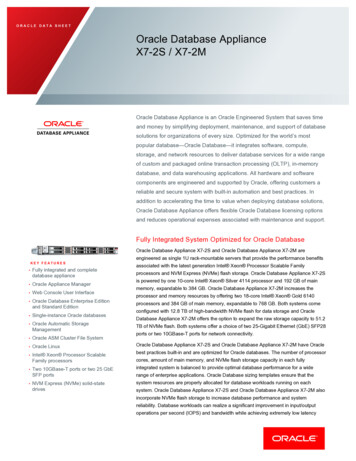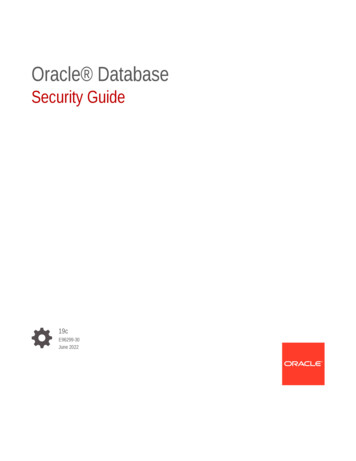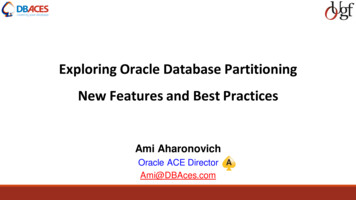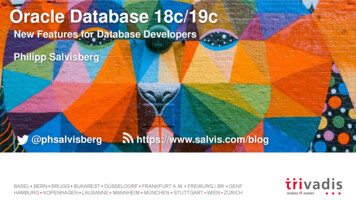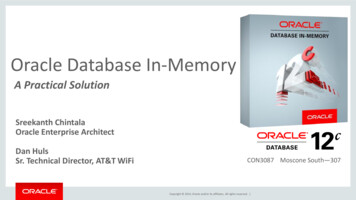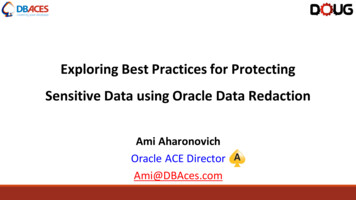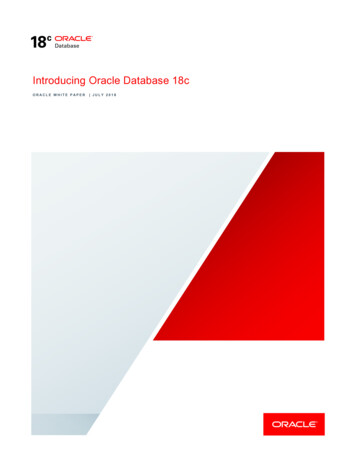
Transcription
Introducing Oracle Database 18cORACLE WHITE PAPER JULY 2018
DisclaimerThe following is intended to outline our general product direction. It is intended for informationpurposes only, and may not be incorporated into any contract. It is not a commitment to deliver anymaterial, code, or functionality, and should not be relied upon in making purchasing decisions. Thedevelopment, release, and timing of any features or functionality described for Oracle’s productsremains at the sole discretion of Oracle.INTRODUCING ORACLE DATABASE 18C
Table of ContentsDisclaimer1Introduction1Journey to Autonomous Database Cloud2Multitenant Architecture2Performance4High Availability5Security7Data Warehousing and Big Data8Application Development9Conclusion0 INTRODUCING ORACLE DATABASE 18C11
IntroductionOracle Database 18c, is the latest generation of the world’s most popular database, and may bedeployed on-premises and/or in Oracle Cloud running on general purpose hardware or engineeredsystems specifically designed for database workloads such as Oracle Exadata and Oracle DatabaseAppliance. It provides businesses of all sizes with access to the world’s fastest, most scalable andreliable database technology for secure and cost-effective deployment of transactional and analyticalworkloads in the Cloud, on-premises and Hybrid Cloud configurations. Oracle Database 18c adds newfunctionality and enhancements to features previously introduced in Oracle Database 12c, including:» Multitenant Architecture for massive cost savings and agility.» In-Memory Column Store for massive performance gains for real-time analytics.» Native Database Sharding for high availability of massive web applications.» Many more critical capabilities for enhanced database performance, availability, security,analytics and application development.In July 2017, Oracle transitioned to a more flexible and responsive strategy for the database softwarerelease process designed to bring new features to market every year. The general availability ofOracle Database 18c was the first annual release in Oracle’s database software release model. Forcomparative purposes, Oracle Database 18c may be viewed as what would have been the first patchset to Oracle Database 12c Release 2 in the previous release model. Looking forward, customers willno longer have to wait multiple years for the latest generation of Oracle Database, and can anticipatethe introduction of new database features and enhancements on a regular annual basis. OracleDatabase 18c (and subsequent annual releases) also features prominently as a core component ofOracle’s Autonomous Database Cloud.This white paper discusses some of the critical capabilities of Oracle Database 18c that can helpcustomers deliver the best performance, scalability, reliability and security for all their transactional andanalytical workloads, and application development requirements.1 INTRODUCING ORACLE DATABASE 18C
“With a history of established leadership in the database software market segment, it is no surprise that Oracle ispioneering a next-generation data management platform.”CARL OLOFSONRESEARCH VICE PRESIDENT, IDCJourney to Autonomous Database CloudOver successive database releases, Oracle has introduced innovative automated features that have helped administratorsdeliver a superior level of service to their end users. These innovations include:» Cost-based Optimization. Automatic SQL query optimization, automatic statistics gathering, automatic query rewriteautomatic SQL Plan management and automatic SQL tuning.» Performance Tuning and Diagnostics. Automatic memory and resource management, automatic index andmaterialized view advisors, Automatic Database Diagnostic Monitor, Automatic Database Workload capture & replay andAutomatic Workload Repository.» Data Optimization. Automatic undo management, automatic segment space management, Automatic StorageManagement, Automatic Data Optimization and automatic columnar cache.» Cloud-Scale Operations. Automatic standby management (broker), Diagnostic Framework, Multitenant Architecture,automatic database clone refresh and machine learning in Cluster Health Advisor.In October 2017, Oracle announced the Autonomous Database Cloud, a range of database services tailored for specificData Warehousing, OLTP, and NoSQL workloads. By utilizing existing database functionality with machine-learningtechniques, the Autonomous Database Cloud can provide a level of performance and reliability that manually manageddatabases struggle to deliver. The Autonomous Database Cloud is specifically designed to provide customers with a higherlevel of service at lower cost by automating routine administrative tasks and eliminating human error through:» Self-Driving. Users simply define workloads and policies, and database automation makes them happen.» Self-Securing. Protection from both external attacks and internal users.» Self-Repairing. Automated protection from all downtime.The Autonomous Database Cloud is built on top of the world’s most widely proven and sophisticated database: OracleDatabase, it runs on the world’s best database platform: Oracle Exadata, and will be available as pay-as-you-go services onOracle Cloud and Exadata Cloud at Customer (for public cloud and private cloud deployment respectively).Figure 1. Key Components of Oracle Autonomous DatabaseThe Autonomous Data Warehouse Cloud for Data Warehouse, Data Mart, Data Science and Data Lake use cases, hasbeen available in Oracle Cloud since March 2018.2 INTRODUCING ORACLE DATABASE 18C
Multitenant ArchitectureDesigned for the cloud (public or private), Oracle’s multitenant database offers a unique architecture that simplifies consolidationand delivers the high density of schema-based consolidation, but without requiring changes to existing applications. In thisarchitecture, a single multitenant container database (CDB) can host many ‘pluggable’ databases (PDBs). Each databaseconsolidated or ‘plugged in’ to a multitenant container looks and feels to applications the same as for pre-multitenant Oracledatabases. By consolidating multiple databases into a multitenant container, many pluggable databases share the containermemory and processor resources, thereby enabling a greater level of database consolidation density. In addition, all PDBs in a CDBare all effectively “managed as one” for database backup, patching, upgrading and standby operations.Oracle’s multitenant database also enables rapid database provisioning, cloning and movement. For example, if the underlyingfilesystem supports copy on writes (e.g. ZFS Filesystem, ASM Cluster Filesystem, etc.), cloning of pluggable databases can occuralmost instantaneously. Other agility features of Oracle’s multitenant database include:» PDB Hot Clone enables fast instantiation of PDBs without having to take users offline.» PDB Refresh enables cloned PDBs to be regularly updated with latest data.» PDB Relocate enables PDBs to be relocated between CDBs with near zero downtime.In addition, the Application Container capabilities of Oracle’s multitenant database allow an application, formerly architected forstandalone deployment on-premises, to be converted to an instant Software-as-a-Service (SaaS) architecture, with no codechanges. The application is simply installed, unchanged, into an Application Root, and tenant PDBs (e.g. for separate customers)can share the application code while retaining secure isolation of tenant data. Application upgrades need only be applied to thesingle Application Root master and tenant PDBs simply synchronize with the upgraded master.Since its introduction in 2013, Oracle’s multitenant database has been widely adopted by ISVs and customers alike and deployedboth on-premises and in the Cloud. Indeed, many Oracle Cloud Database Services including the Exadata Express Service andAutonomous Data Warehouse Cloud rely on multitenant for tenant isolation, agility and scalability. The release of Oracle Database18c introduces a number of enhancements to existing multitenant functionality including:» Faster Deployment of Upgrades, Updates and Revisions. A new infrastructure further reduces the execution time of databaseupgrades, updates and revisions.» Transportable Backups support the use of backups performed on a PDB prior to it being unplugged and plugged into a newcontainer. This facilitates agile relocation of PDBs between CDBs, perhaps for load balancing or migration between on-premisesand cloud, without requiring backups to be taken immediately before, and after, each PDB relocation.» Snapshot Carousel enables customers to define regular snapshots of PDBs that can then be used for a full point in timerecovery or to a specific point in time clone. The Snapshot Carousel is ideally suited to development environments, that typicallyrequire multiple copies of databases at different points in time, or to augment a non mission critical back and recovery process.» Refreshable PDB Switchover enables customers to create a PDB, which is an incrementally updated copy of a “master” PDB(e.g. from on-prem to Cloud), that may subsequently be switched over between each other. When this happens the “master” PDBbecomes the clone and the old clone the master. This capability will make it even easier for customers to gracefully switchworkloads between different CDBs.The multitenant architecture of Oracle Database cost-effectively enables tenant isolation, and agility with economies of scale,whether deployed in the Oracle Cloud, on-premises or hybrid cloud environments.3 INTRODUCING ORACLE DATABASE 18C
PerformanceOracle Database 18c inherits the raft of innovations in the areas of SQL query and data optimizations, and performance and tuningdiagnostics that have helped customers deliver on database performance level expectations for transactional, analytic and mixedworkloads, on both single server and clustered server configurations. In addition, the unique performance features of OracleExadata, such as Smart Scans, Smart Flash Cache and Storage Indexes, offer customers even greater levels of performance for allOracle Database 18c workloads running on Exadata, either on-premises or in Cloud deployments.Oracle Database also provides customers access to in-memory columnar formatted data with Oracle Database In-Memory. This canaccelerate analytic queries by orders of magnitude and improve the performance of transactional queries by removing the need foranalytic reporting indexes. Oracle Database In-Memory uses a unique dual-format architecture that simultaneously represents tabledata in its traditional row format, and in a pure in-memory columnar format. The In-Memory column store (IM column store) isaccessed through specialized software and hardware routines that amplify the performance of memory-resident data. OracleDatabase 18c further improves Oracle Database In-Memory automation and increases its flexibility and performance, whilemaintaining complete compatibility with existing applications and all Oracle Database 18c functionality, including Multitenant, RealApplication Clusters, Maximum Availability Architecture, and database security.Simple To ImplementUnlike other in-memory databases, Oracle Database In-Memory does not require the entire database to fit into main memory. Itsimply requires setting the size of the IM column store and identifying performance sensitive tables or partitions. With OracleDatabase 18c, the management of the IM column store content can now be automated, which means that the databaseautomatically takes care of populating objects into the IM column store and removing those that are no longer relevant. A uniquefeature of Database In-Memory is that no changes to existing applications are required to take advantage of the IM column store.The optimizer automatically routes analytic queries to the columnar format and transactional queries to the row format. In addition,the IM column store is extended to flash on Exadata storage (both on-premises and Oracle Cloud), dramatically enlarging thecapacity of columnar formatted data.Memory-Optimized PerformanceOracle Database In-Memory’s state-of-the-art algorithms for in-memory scans, joins and aggregations are widely proven to deliverorders-of-magnitude performance improvements for customers’ analytical and mixed workloads. In addition, other typical use-casesfor Oracle Database In-Memory include hybrid transactional analytic processing (HTAP), where analytics are an integral componentof business transactions, as well as data warehouse query and reporting systems. Oracle Database In- Memory’s performanceenhancing features include; In-Memory Join Groups, In-Memory Expressions and in-memory processing of JSON queries.Distributed Real-Time AnalyticsOracle Database In-Memory enables real-time analytics by delivering performance similar to having an index on every column, butwithout the index overheads. Consequently, analytics that previously took hours or longer to run can now can complete in seconds.Indeed, customers can eliminate secondary analytical indexes on transactional databases that are no longer required for analyticquery performance. Customers can also maintain an IM column store on an Active Data Guard standby database running on OracleCloud and Oracle Exadata. This allows customers to make more productive use of their standby databases. It completely isolatestransactional users from analytic users, and still delivers high performance analytics against near-real-time data.MemOptimized RowStoreIn addition to Oracle Database In-Memory column store and non-volatile memory support, Oracle Database 18c introduces aMemoptimized Rowstore designed for fast query performance such as Internet of Things (IoT) workloads that require very fast andlow latency lookups based on primary key values. A new table level attribute, MEMOPTIMIZE FOR READ, is used to indicate whichtables are to be pinned into the buffer cache with this new hash index. Key-value lookups then bypass the SQL execution layer andexecute directly in the data access layer via an in-memory hash index. This feature enables clients to perform very low-latencyreads from the in-memory buffer, which can significantly increase the throughput of key-value lookups compared to conventionalmethods. This fast lookup performance can be further enhanced when used with Exadirect for Infiniband high-speed networks byleveraging the ability to use Remote Direct Memory Access (RDMA).4 INTRODUCING ORACLE DATABASE 18C
High AvailabilityOracle Database offers customers the highest levels of availability with Oracle’s Maximum Availability Architecture; an integrated setof database availability feature and best practice blueprints that address the common causes on unplanned and planned downtimefor both on-premises and in-Cloud deployments.Unplanned DowntimeIT infrastructures are prone to failures such as server faults, disk crashes or storage corruption, site outages and human error thatcan incur costly unplanned downtime. In order to prevent and mitigate unplanned downtime Oracle Database 18c offers a number ofcritical high availability capabilities including:» Real Application Clusters (RAC) enables multiple database instances to run on multiple servers in a cluster against a shareddatabase. Since the servers run independently, the failure of one or more does not affect the others; RAC effectively removes thedatabase server as a single point of failure.» Automatic Storage Management (ASM) is the underlying (clustered) volume manager technology recommended for used withOracle Database. ASM stripes and mirrors everything for faster performance and higher availability, with a choice 2-or 3-way diskmirroring to protect data from disk failures.» Recovery Manager (RMAN) manages Oracle database backup, restore, and recovery processes. It maintains configurablebackup and recovery policies, and keeps historical records of all database backup and recovery activities, thereby ensuring that allfiles required to successfully restore and recover a database are included in database backups.» Oracle Secure Backup (OSB) delivers scalable, centralized tape backup management for both database and file system data indistributed, heterogeneous IT environments. This includes RMAN backups to Oracle object store and Amazon S3 object storage.» Flashback enables reversing of human errors by efficiently undoing the effects of a mistake (e.g. an accidental table drop).» Active Data Guard (ADG) enables protection from site failures by maintaining replica standby databases (synchronously orasynchronously) in alternative (typically remote) location. ADG also enable customers and offload read-only processing (e.g.backups, reports, analytics, etc.) to standby databases.Oracle Exadata and many of Oracle Cloud’s database services (e.g. Exadata Service and Autonomous Services) are built usingthese critical high availability capabilities using Oracle’s Maximum Availability Architecture to offer customers the highest levels ofdatabase availability, both on-premises and on Oracle Cloud.Planned DowntimePlanned downtime for essential maintenance such as hardware upgrades, software upgrades and patching are part and parcel ofevery IT operation. Nonetheless, downtime (planned or otherwise) can be costly and Oracle Database 18c offers a number ofcapabilities to help customers reduce the amount of planned downtime required for maintenance activities, including:» Hardware Maintenance and Migration Operations Using Automatic Storage Management, disks can be added or removedonline and the data is automatically rebalanced. Database servers can also be easily added or removed to a clustered databaseinfrastructure while users remain connected. Cross platform incremental backup and recovery minimizes downtime for crossplatform hardware migrations, as does fast unplug and plug of PDBs between multitenant containers on different servers.» Online Patching of database software can be applied to server nodes in a ‘rolling’ manner using Oracle Real ApplicationClusters. Users are simply migrated from one server to another; the server is quiesced from the cluster, patched, and then put backonline. The same operation is then repeated for every server in the cluster. With Oracle Database 18c, zero impact patching of gridinfrastructure patches each of the nodes Grid Infrastructure software in a rolling fashion whist the databases running on that nodecontinue to be available to the application users.» Rolling Database Upgrades Oracle Data Guard or Oracle Active Data Guard enables upgrading of a standby database, testingof the new (upgraded) environment and then switching users to the new environment, without any downtime.» Online Redefinition Oracle Database allows changes to a table structure while continuing to support an online productionsystem, and data files and partitions may be moved around storage devices while users continue to access underlying data.» Edition Based Redefinition enables online application upgrades. Using edition-based redefinition, changes to program code canbe made in the privacy of a new edition within the database, separated from the current production edition. An editioning viewexposes different projections of the same table into each edition, ensuring that the code in each edition only sees its own specificview of the table. Cross edition triggers propagate the data changes made by the old production edition into the new edition’scolumns, and vice-versa. This then allows both the old production environment and the new production environment to be used atthe same time, for testing, and allows users to be moved online from one edition to the other.5 INTRODUCING ORACLE DATABASE 18C
Enhancing Database AvailabilityOracle Database 18c continues to evolve the Maximum Availability Architectures with new and enhanced capabilities that helpcustomers maximize their database availability, these include:» Data Guard Far Sync provides zero data loss protection for a production database by maintaining a synchronized standbydatabase located at any distance from the primary location, without impacting database performance and with minimal cost orcomplexity. A far sync instance receives changes synchronously from a primary database and forwards them asynchronously to aremote standby. It’s a lightweight entity that manages only a control file and log files, and only requires a fraction of the CPU,memory, and I/O resources of a standby database to relieve a primary database from serving remote destinations. Production canbe quickly failed over, manually or automatically, to the remote standby database with zero data loss.» Global Data Services provides inter-region and intra-region load balancing across Active Data Guard and Golden Gate replicateddatabases. It effectively provides Real Application Cluster failover and load balancing capabilities to Active Data Guard and GoldenGate distributed databases. Global Data Services extends the familiar notion of Database Services to span multiple databaseinstances in near and far locations and can be used to distribute workloads across a reader farm composed of standby databases.» Auto Propagation of Nologged Data is enabled in Oracle Database 18c which means that customers no longer have to makecompromises between no-logging to rapidly load data into their data warehouses and maintaining a replica standby database.Customers can now ensure that standby databases receive non-logged data changes with minimal impact on the speed of loadingdata into the primary data warehouse.» Continuous Application Availability effectively manages database failures from user-facing applications. For example, when aweb application encounters any database outage it can result in transactions not completing properly or transactions being reentered by the user. While the database outage can be easily recovered, the same may not be true for the application itself.Application Continuity enables failed transaction replay, effectively masking database outages from the end user.Native Database ShardingOracle Database offers customers native database sharding for massive scalability and reliability for transactional applications.Critical high availability capabilities such as Real Application Clusters and Active Data Guard are widely proven to meet the needs ofover 99% of transactional applications, while preserving application transparency. However, some global-scale transactionalapplications prefer to shard massive databases into a farm of smaller databases for scalability and reliability purposes. This requiresdesigning applications around a sharding key, so that workloads are automatically routed to specific shards in a database farm.Sharding with Oracle Database 18c introduces an explicit user defined model of “Range” and “List” sharding, giving users the abilityto ensure that data is placed in a location appropriate for its access.Zero Data Loss Recovery Appliance (Recovery Appliance)The Oracle Recovery Appliance is an engineered system for standardizing backup and recovery process of Oracle Databasesthroughout the enterprise. It’s an innovative data protection solution that is completely integrated with RMAN and designed toeliminate data loss exposure and dramatically reduces data protection overhead on database servers. The Recovery Appliance caneasily standardize the protection of all Oracle databases in the data center with its massive cloud-scale architecture, end-to-enddata validation, and fully automated management of the entire data protection lifecycle through Enterprise Manager Cloud Control.6 INTRODUCING ORACLE DATABASE 18C
SecurityEnterprise data is increasingly under threat from malicious attacks, and regulations such as EU GDPR require organizationsdemonstrate stronger controls to protect sensitive data. From the outset, Oracle has adopted a multi-layered, defense-in-depthapproach providing customers with evaluative controls for assessing the security posture of their databases and sensitivity of theirdata, preventive controls to block unauthorized access to data, detective controls to monitor user and application data accessbehavior, and data driven security to enforce user-and application-level data access controls at the source, within the database.These controls protect enterprise data stored in Oracle Database both on-premises and in the Oracle Cloud, include:» Transparent Data Encryption helps protect against threats that target database storage and backup media devices. Encryptioncan be easily applied to sensitive columns in tables or entire tablespaces and prevents access to data when database files are lost,stolen or read directly from media.» Dynamic Data Masking with Oracle Data Redaction helps protect sensitive data in production applications by enforcing controlsinside the database that redact data before it is returned to the application. It effectively hides the true values of sensitive data in away that is transparent to applications, delivering (for example) just the last few digits of social security or bank account numbers. Bydefining and enforcing data redaction policies in the database, and not the application, customers can effectively protect sensitivedata without changing their applications.» Separation-of-duties and Least Privilege Access Policies The privilege analysis feature effectively records existing privilegeand role usage in order to help customers deploy ‘least privilege’ models that accurately reflect the privileges required for day-to-daybusiness and administration activities. This helps reduce the security risk of over-provisioning user access to enterprise data.Customer’s least privilege model may be further secured using Database Vault to enforce separation of duties enterprise-wide for allconstituent users and roles, including those of privileged users.» First Line of Defense using Oracle Database Firewall provides a first line of defense with both detective and preventive controlsfor monitoring and blocking unauthorized SQL traffic before it reaches the database. Database Firewall employs a sophisticatedSQL grammar analysis engine that inspects SQL statements going to the database and determines with high accuracy whether toallow, log, alert, substitute, or block the SQL, making it an effective control for detecting and blocking SQL injection attacks.» Unified Audit Oracle Database offers customers an auditing architecture that is both policy-based and context-aware, completewith roles for managing auditing policies (e.g. based on factors such as time of day, IP address, program name, and proxy username) and the viewing of audit data. Oracle Audit Vault collects audit data from systems and databases both on-premises and inthe cloud, providing a secure retention policy and compliance reporting» Active Directory Integration Oracle Database 18c simplifies the integration with Microsoft’s Active Directory. It allows customersto use Active Directory for authentication and authorization of users directly, without the need to utilize Oracle Internet Directory(which was required prior to Oracle Database 18c). This change significantly reduces the complexity (with less component required)needed to manage authentication and authorization, while also improving user security and LDAP availability enterprise-wide.» Encryption Key Management Comprehensive management of encryption keys, certificates, wallets, and credentials has becomea vital part of organization's security ecosystem. Oracle Key Vault is a secure key management platform that helps facilitate thedeployment of encryption throughout the enterprise, both on-premises and in the Cloud. It enables customers to centrally manageencryption keys, Oracle Wallets, Java Keystores, and credential files. Oracle Key Vault includes a browser-based managementconsole for administration tasks such as provisioning server endpoints, securely managing key groups, and reporting on access tokeys.» Masking and Subsetting Data Securing enterprise data is not limited to production systems and the practice of copyingdatabases for development, testing and other purposes can create additional risks of data exposure. Oracle Data Masking andSubsetting helps customers improve security, accelerate compliance, and reduce IT costs by sanitizing copies of productiondatabases for non-production usage. It enables entire copies, or subsets, of enterprise data to be extracted from productiondatabases and obfuscated while preserving referential integrity for development, testing and other purposes. Masking andsubsetting of data is fully supported on-premises, on Oracle Cloud and for copying databases between both environments.Database Security Assessment ToolA recent addition to Oracle’s defense in depth capabilities is the Oracle Database Security Assessment Tool (DBSAT), which helpscustomers identify areas where their Oracle databases may be at risk and recommends changes and controls to mitigate thoserisks. DBSAT is provided for use with Oracle Databases and also enables customers to quickly find the location, type, and quantityof sensitive data contained in their applications, and provides actionable reports with prioritized recommendations to quickly addresspotential vulnerabilities.7 INTRODUCING ORACLE DATABASE 18C
Data Warehousing and Big DataOracle Database 18c provides customers with industry-leading performance, reliability and security for both transactional andanalytic workloads, that can easily scale to meet the most demanding requirements whether deployed on-premises or in the Cloud.From an analytics perspective, Oracle Database features a wide range of optimizations such as analytic views, queryapproximations, and in-memory property graph analytics that can help customers efficiently measure business performance andperform predictive analytics. Oracle Database is a multi-mode- database that provides fu
materialized view advisors, Automatic Database Diagnostic Monitor, Automatic Database Workload capture & replay and Automatic Workload Repository. » Data Optimization. Automatic undo management, automatic segment space management, Automatic Storage Management, Automatic Data Optimization and automatic columnar cache. » Cloud-Scale Operations.



